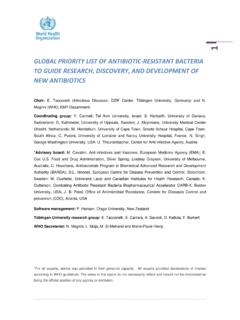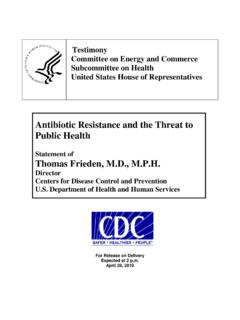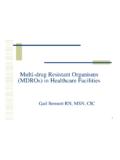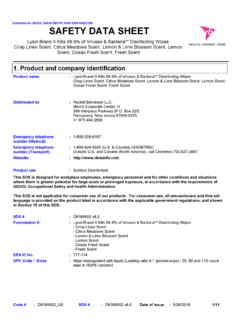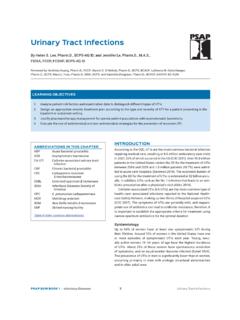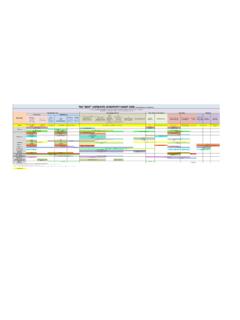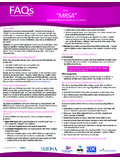Transcription of BACTERIA, ANTIBIOTICS AND ANTIBIOTIC RESISTANCE
1 bacteria , ANTIBIOTICS AND ANTIBIOTIC RESISTANCE Photo: Mycobacterium tuberculosis bacteria , NIAID (from flickr).1 Photo: Staphylococcus epidermidis bacteria , NIAID (from flickr).2 By ReAct Funding from Marie-Claire Cronstedts Stiftelse BASIC LECTURE OUTLINE OF THIS LECTURE About bacteria About ANTIBIOTICS ANTIBIOTIC RESISTANCE How does it form and spread? What are the consequences for global health? What can you do? ABOUT bacteria bacteria are small (microscopic size) organisms that can be found in most environments, for example in soil, water and on and inside the human body There are around 50 million bacteria in every gram of surface soil We would not survive without them!
2 Help degrade the food we eat Protect against pathogens Photo: bacteria , Umberto Salvagnin (from flickr).3 A few bacteria can be dangerous to our health by causing infections and even death We can get them from outside the body: Other humans, animals, food, water Sometimes our own bacteria can cause disease Examples of bacterial infections: Pneumonia Blood stream infections Urinary tract infections Wound infections The sexually transmitted disease gonorrhea DISEASE-CAUSING bacteria Photo: Klebsiella pneumoniae, NIAID (from flickr). 4 ANTIBIOTICS are medicines for bacterial infections Examples of ANTIBIOTICS : Penicillin and Ciprofloxacin Penicillin was discovered by Alexander Fleming in 1928 Introduced as medicine in the 1940 s ANTIBIOTICS can have broad or narrow spectrum Broad spectrum: Active against many different types of bacteria Narrow spectrum: Active against one or a few types of bacteria ANTIBIOTICS Photo: ANTIBIOTICS , Michael Mortensen (from flickr).
3 5 ANTIBIOTICS do not work against viruses! ANTIBIOTICS European ANTIBIOTIC Awareness Day key messages, ECDC. Examples of viral infections: The common cold The flu (influenza) ANTIBIOTICS ANTIBIOTICS are effective against bacteria However, ANTIBIOTICS have only marginal effect against some bacterial infections such as uncomplicated sinus infections and ear infections (bacterial otitis) The body s immune system can normally take care of these infections without ANTIBIOTICS But for some bacterial infections ANTIBIOTICS are life-saving medicines! For example for blood stream infections (sepsis) and pneumonia Before ANTIBIOTICS there was no effective cure for bacterial infections ANTIBIOTICS were considered a miracle cure ANTIBIOTICS cure infections, prevent infections upon surgery, and make transplantations and cancer treatment safer ANTIBIOTICS Saved countless lives!
4 Made modern medicine possible! ANTIBIOTICS are the cornerstones of modern medicine! ANTIBIOTICS Photo: M. Pr nting Massive use of ANTIBIOTICS the past 80 years, both appropriate and inappropriate has lead to: ANTIBIOTIC RESISTANCE Photo: Drug RESISTANCE by Iqbal Osman (from flickr). 6 Increased occurrence and spread of bacteria that are resistant to ANTIBIOTICS ANTIBIOTIC RESISTANCE = The ability of bacteria to protect themselves against the effects of an ANTIBIOTIC ANTIBIOTIC RESISTANCE bacteria are experts at surviving in changing environments In large bacterial populations there are often a few resistant bacteria ANTIBIOTICS select for resistant bacteria ANTIBIOTIC RESISTANCE Population of mainly susceptible bacteria ANTIBIOTICS kill or stop growth of susceptible bacteria ANTIBIOTIC RESISTANCE ANTIBIOTICS select for resistant bacteria ANTIBIOTIC RESISTANCE Is ANTIBIOTIC RESISTANCE a problem?
5 ANTIBIOTIC RESISTANCE leads to treatment failures ANTIBIOTIC RESISTANCE threatens our ability to perform modern medical procedures ANTIBIOTIC RESISTANCE imposes a major economic burden on society ANTIBIOTIC resistant bacteria already cause many deaths around the world ANTIBIOTIC resistant bacteria each year cause: More than 38,000 deaths in Thailanda More than 23,000 deaths in the USAb 25,000 deaths in the European Unionc ANTIBIOTIC RESISTANCE Photo: Methicillin- resistant Staphylococcus aureus (MRSA) bacteria by NIAID (from flickr) 7 aPhumart P, Phodha T et al. Health and Economic Impacts of Antimicrobial resistant Infections in Thailand: A Preliminary Study. J. Health Syst Res. (2012) 6(3).
6 BUS Centers for Disease Control and Prevention. ANTIBIOTIC RESISTANCE threats in the United States, 2013. (2013). cECDC/EMEA. Technical Report. The bacterial challenge: time to react. (Sept 2009).. but the consequences of ANTIBIOTIC RESISTANCE are most severe for the poor. For example: In South Asia (India, Pakistan, Afghanistan, Nepal, Bangladesh) one newborn child dies every 5 minutes from blood stream infections (sepsis) because the ANTIBIOTICS given are not effective due to bacterial resistancea ANTIBIOTIC RESISTANCE aBhutta Z, Presentation at the Global Need for Effective ANTIBIOTICS - Moving towards Concerted Action. ANTIBIOTIC RESISTANCE is a global issue! Exists on all continents Affects both low- and high income countries Affects both strong and weak health systems ANTIBIOTIC RESISTANCE Photo: The Blue Marble, Eastern Hemisphere March 2014, NASA Goddard Space Flight Center (from flickr).
7 8 How did we end up here? How did we end up here? USE & INAPPROPRIATE USE OF ANTIBIOTICS Use in human and animal medicine Use to increase growth of farm animals Use for routine prophylaxis in farm animals Selection and maintenance of RESISTANCE SPREAD OF resistant bacteria Poor hygiene and sanitation Food and water Travel How did we end up here? USE & INAPPROPRIATE USE OF ANTIBIOTICS Selection and maintenance of RESISTANCE How did we end up here? SPREAD OF resistant bacteria USE & INAPPROPRIATE USE OF ANTIBIOTICS Selection and maintenance of RESISTANCE LACK OF NEW ANTIBIOTICS The last new ANTIBIOTIC class that has been introduced as medicine was discovered in 1987 Older ANTIBIOTICS are rapidly becoming ineffective due to ANTIBIOTIC RESISTANCE No new drugs for typhoid fever, gonorrhea, blood stream infections or postoperative infections Some bacteria already resistant to all available ANTIBIOTICS LACK OF NEW ANTIBIOTICS Adapted from Silver 2011 WHAT CAN YOU DO?
8 Use ANTIBIOTICS only when you need it Not for a common cold or the flu Ask your doctor for advise Don t pressure Don t self medicate Wash your hands, Before and after handling and preparing food After visiting the bathroom Teach others about ANTIBIOTIC RESISTANCE ! Thank you for your attention! For more information about ANTIBIOTIC RESISTANCE , please visit: 1 Photo: Mycobacterium tuberculosis bacteria , the Cause of TB by NIAID (from flickr) License: 2 Photo: Staphylococcus epidermidis bacteria by NIAID (from flickr) License: 3 Photo: bacteria by Umberto Salvagnin (from flickr) License: 4 Photo: Klebsiella pneumoniae by NIAID (from flickr) License: 5 Photo: ANTIBIOTICS by Michael Mortensen (from flickr) License: 6 Photo: Drug RESISTANCE by Iqbal Osman (from flickr) @N06/9502114881/ @N06/ License: Downloaded 2015-02-05 7 Photo: Methicillin- resistant Staphylococcus aureus (MRSA) bacteria by NIAID (from flickr) License.
9 Downloaded 2015-02-05 8 Photo: The Blue Marble, Eastern Hemisphere March 2014 by NASA Goddard Space Flight Center (from flickr) License: All images downloaded 5th of Nov 2014 unless otherwise specified Image references
